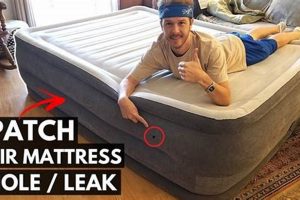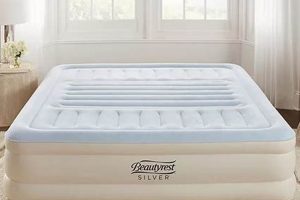The process of repairing a breach in the inflatable structure designed for temporary sleep or recreational use is a common requirement. This involves identifying the location of the damage, preparing the surrounding area, and applying a suitable adhesive material or patch to restore its airtight integrity. Effective repair ensures the continued functionality and lifespan of the inflatable item.
Addressing imperfections in such items is crucial for maintaining comfort and preventing deflation during use. Historically, various materials and methods have been employed, from simple adhesives to specialized repair kits. Successfully executing this procedure provides a cost-effective alternative to replacement and minimizes waste.
The subsequent sections will detail specific techniques for identifying the location of imperfections, preparing surfaces, selecting appropriate repair materials, and applying those materials for a durable and effective seal. These comprehensive instructions aim to equip individuals with the knowledge and skills necessary for successful maintenance and repair.
Tips for Repairing Inflatable Sleeping Surfaces
Proper maintenance and timely repair are essential for extending the life of inflatable sleeping surfaces. Adhering to these guidelines will improve the success rate of repairs and minimize future issues.
Tip 1: Identify the Leak. Submerge the inflated mattress in water or apply a soapy solution to the surface. The presence of bubbles indicates the location of the breach.
Tip 2: Clean the Affected Area. Thoroughly clean the area surrounding the breach with isopropyl alcohol. This removes oils and debris, ensuring a strong adhesive bond.
Tip 3: Select the Correct Repair Material. Use a patch specifically designed for vinyl or PVC materials. Generic adhesives may not provide a lasting seal.
Tip 4: Apply Adhesive Sparingly. Excessive adhesive can weaken the repair. A thin, even layer is sufficient for bonding the patch to the mattress surface.
Tip 5: Apply Pressure. After applying the patch, apply firm, consistent pressure for the recommended duration specified by the adhesive manufacturer. This promotes proper bonding.
Tip 6: Allow Sufficient Drying Time. Do not inflate the mattress immediately after applying the patch. Allow the adhesive to fully cure according to the manufacturer’s instructions. Premature inflation can compromise the repair.
Tip 7: Test the Repair. After the curing period, partially inflate the mattress and check for leaks around the repair area. If leaks persist, repeat the repair process.
Implementing these guidelines will significantly increase the durability and longevity of repairs, minimizing the need for frequent replacements.
The following section will address advanced repair techniques and alternative solutions for more complex situations.
1. Location Identification
The successful repair of an inflatable sleeping surface is intrinsically linked to the accurate and efficient identification of the breach. Precise localization prevents wasted effort, conserves repair materials, and ensures a durable and effective restoration of the item’s airtight seal. Without effective localization, the repair process becomes significantly more challenging and prone to failure.
- Auditory Detection
The use of auditory cues, such as listening for escaping air, can indicate the general area of the breach. This method is most effective in quiet environments and can be enhanced by placing the ear close to the surface of the inflated mattress. However, auditory detection provides only an approximation, necessitating further, more precise methods.
- Tactile Examination
Carefully running a hand over the surface of the inflated mattress can sometimes reveal the presence of a small breach. A slight draft or the sensation of air escaping may be detectable. This method is particularly useful for identifying larger breaches or areas with significant air leakage.
- Soapy Water Application
Applying a solution of soapy water to the surface of the inflated mattress is a widely used and highly effective method for pinpointing the location of breaches. The escaping air will create bubbles at the site of the imperfection, clearly indicating the need for repair. This technique is applicable to a wide range of breach sizes and is relatively simple to execute.
- Submersion Testing
Submerging the inflated mattress in water allows escaping air to be readily observed as bubbles. This method is particularly useful for locating multiple breaches or for identifying breaches in hard-to-reach areas. However, it is important to ensure that the mattress is thoroughly dried after submersion to prevent mold or mildew growth.
In conclusion, the ability to accurately pinpoint the site of an air leak through meticulous localization techniques is not merely a preliminary step but a fundamental prerequisite for the efficient and enduring restoration of inflatable sleeping surfaces. The choice of technique will depend on factors such as ambient noise, size of the suspected breach, and available resources; however, a combination of these approaches often yields the most reliable results.
2. Surface Preparation
Surface preparation is a critical determinant in the effectiveness of any repair applied to inflatable mattresses. Contaminants such as dirt, oil, and moisture inhibit the proper adhesion of patching materials. A failure to adequately prepare the surface directly leads to a compromised bond, resulting in premature patch failure and continued air leakage. This renders the repair temporary and necessitates repeated efforts, ultimately shortening the lifespan of the inflatable item.
Consider a scenario where an inflatable mattress is used outdoors. The surface inevitably accumulates dust and potentially oily residues from skin contact. Applying a patch directly to this unprepared surface will result in a weak adhesive bond. Within a short period, the patch will peel away, especially under the stress of inflation and usage. In contrast, meticulous cleaning with isopropyl alcohol removes these contaminants, creating a clean and receptive surface for the adhesive to bond effectively. This practice significantly extends the durability and reliability of the repair.
In summary, surface preparation constitutes an indispensable step in achieving a long-lasting repair of inflatable mattresses. The absence of proper surface preparation negates the potential benefits of high-quality patching materials and precise application techniques. Overlooking this element inevitably leads to unsatisfactory outcomes, highlighting its critical role in the overall repair process. The challenges as
sociated with maintaining cleanliness, particularly in field conditions, can be mitigated through the use of readily available cleaning agents and careful attention to detail.
3. Appropriate Material
The selection of appropriate material is paramount to achieving a successful and durable repair of inflatable mattresses. The composition of the patching material must be compatible with the mattress material to ensure a strong and lasting bond. Incompatibility leads to adhesive failure and repeated leakage.
- Vinyl Composition
Many inflatable mattresses are constructed from polyvinyl chloride (PVC), commonly known as vinyl. Repairing a vinyl mattress necessitates the use of a patch made of similar vinyl material. Vinyl patches possess inherent flexibility and adhesive properties that promote a robust bond with the existing mattress material. Using alternative materials, such as cloth or paper-based patches, will result in inadequate adhesion and a high likelihood of failure under pressure.
- Adhesive Compatibility
The adhesive used in conjunction with the patch must exhibit compatibility with both the patch material and the mattress material. Certain adhesives, such as cyanoacrylate-based glues (super glue), can damage or degrade vinyl surfaces. The optimal approach involves using an adhesive specifically formulated for vinyl repair, which provides a flexible and durable bond without compromising the integrity of the surrounding material.
- Patch Thickness and Flexibility
The thickness and flexibility of the patch material should closely match the characteristics of the mattress. A patch that is excessively thick or rigid can create stress points around its perimeter, leading to new leaks. Conversely, a patch that is too thin may lack the structural integrity to withstand the pressure of inflation. A flexible patch that conforms to the contours of the mattress provides the most durable and reliable repair.
- Environmental Resistance
The selected patch material should exhibit resistance to environmental factors such as temperature fluctuations and UV exposure. Inflatable mattresses are often used outdoors, where they are subject to varying weather conditions. Patches that degrade under UV light or become brittle in cold temperatures will fail prematurely. Choosing a UV-resistant and temperature-stable material ensures the longevity of the repair.
The integration of compatible material properties is essential for the sustained performance of repaired inflatable mattresses. Disregarding material compatibility undermines the adhesive bond and diminishes the integrity of the entire patch. The use of compatible materials guarantees that the repair maintains its functionality over an extended period, thereby extending the lifespan of the inflatable mattress.
4. Adhesive Selection
The efficacy of any attempt to restore the integrity of an inflatable mattress is inextricably linked to the appropriate adhesive selection. The adhesive acts as the primary bonding agent between the patching material and the mattress substrate, dictating the repair’s overall strength and durability. Consequently, the choice of adhesive warrants careful consideration.
- Vinyl Adhesives
Given the prevalence of polyvinyl chloride (PVC) in inflatable mattress construction, adhesives specifically formulated for vinyl represent a logical choice. These adhesives are designed to create a chemical bond with the vinyl material, resulting in superior adhesion compared to general-purpose adhesives. For example, specialized vinyl adhesives contain solvents that slightly dissolve the vinyl surface, allowing for a more robust and enduring bond. The use of non-vinyl-specific adhesives often leads to patch failure due to incompatibility and inadequate bonding strength.
- Flexibility and Elasticity
Inflatable mattresses are subjected to expansion and contraction during inflation and deflation, as well as under the weight of the user. The selected adhesive must possess sufficient flexibility and elasticity to accommodate these movements without cracking or losing adhesion. Rigid adhesives, such as cyanoacrylates, are generally unsuitable for this application as they lack the necessary pliability. Flexible adhesives, often based on polyurethane or rubber compounds, maintain their bond even under repeated stress and deformation, contributing to the longevity of the repair.
- Water Resistance
Inflatable mattresses are frequently used in environments where exposure to moisture is likely, such as camping or poolside. Therefore, the chosen adhesive should exhibit a high degree of water resistance to prevent bond degradation and subsequent leakage. Water-soluble adhesives are unsuitable, as they will weaken or dissolve upon contact with moisture. Waterproof or water-resistant adhesives, such as those based on epoxy or certain rubber formulations, provide a more reliable solution in such conditions. Immersion testing is often conducted to verify the water resistance of different adhesive options.
- Curing Time and Application
The curing time and application characteristics of the adhesive significantly impact the efficiency and effectiveness of the repair process. Adhesives with excessively long curing times require prolonged clamping or pressure to ensure proper bonding, which can be inconvenient. Conversely, adhesives that cure too rapidly may not allow sufficient time for accurate patch placement. Furthermore, the viscosity and application method of the adhesive affect its ability to penetrate and bond with the mattress surface. Adhesives that are too thick may not spread evenly, while those that are too thin may run and create a mess. Choosing an adhesive with a moderate curing time and user-friendly application properties facilitates a more controlled and successful repair.
In conclusion, the strategic selection of an adhesive tailored to the specific material, environmental conditions, and usage patterns of an inflatable mattress is paramount to achieving a durable and reliable repair. Failure to consider these factors often results in premature patch failure and continued air leakage, highlighting the critical role of informed adhesive selection in the overall repair process.
5. Application Technique
The application technique employed during the repair of inflatable mattresses directly influences the success and longevity of the mend. Improper application of adhesive and patching materials inevitably leads to compromised structural integrity and subsequent air leakage. The process requires precision and adherence to specific protocols to ensure a durable and airtight seal. For instance, if the adhesive is applied unevenly or in insufficient quantity, the patch may not adhere properly to the mattress surface, resulting in a weak point prone to failure under pressure. Similarly, if air bubbles are trapped between the patch and the mattress during application, they create voids that weaken the bond and provide pathways for air to escape.
A specific example of the
application’s impact can be observed in the field. Consider a scenario where an individual attempts to repair a damaged air mattress while camping. If the individual rushes the process and fails to apply adequate pressure to the patch during the curing period, the resulting bond will be weak. The patch will likely detach prematurely, rendering the mattress unusable. Conversely, a meticulous application, involving thorough surface preparation, even adhesive distribution, firm and sustained pressure, and sufficient curing time, will yield a significantly more resilient repair, capable of withstanding repeated use and inflation cycles. The practical significance of understanding these nuances is substantial, as it directly translates to cost savings, reduced waste, and extended usability of the inflatable mattress.
In summary, the application technique is not merely a procedural step but a critical determinant of the success of patching inflatable mattresses. Challenges may arise due to environmental conditions, limited access to proper tools, or insufficient knowledge of best practices. However, recognizing the direct correlation between application technique and repair outcome is essential for maximizing the effectiveness of repair efforts and minimizing the likelihood of future failures. This understanding contributes directly to the broader goal of sustainable resource management and responsible product use.
6. Curing Time
Curing time represents a critical factor in the successful repair of inflatable mattresses. It refers to the period required for the adhesive to achieve its maximum bonding strength after application. Insufficient curing time compromises the integrity of the repair, leading to premature failure and air leakage.
- Adhesive Bond Strength
The adhesive’s bonding strength develops gradually over time. Premature inflation of the mattress before the adhesive has fully cured places undue stress on the bond, potentially disrupting the formation of a strong, lasting seal. Manufacturers typically specify the minimum curing time required for optimal bond strength. Exceeding this time generally does not hinder the repair, but adhering to it is essential for effectiveness.
- Environmental Factors
Environmental conditions, such as temperature and humidity, can significantly influence the curing time of adhesives. Lower temperatures generally slow the curing process, while higher humidity levels may impede it for certain adhesives. Adjustments to the curing time may be necessary based on the surrounding environment to ensure a robust bond. For instance, a repair performed outdoors in cold weather may require a longer curing time than one conducted indoors at room temperature.
- Patch Material Interactions
The type of patch material used can interact with the adhesive, affecting the curing time. Certain materials may absorb moisture from the adhesive, accelerating the curing process, while others may inhibit it. The manufacturer’s instructions typically provide guidance on compatibility between adhesives and patch materials. Using non-recommended combinations can result in a weakened bond and reduced repair lifespan.
- Inflation Pressure
Applying inflation pressure to the repaired area before the adhesive is fully cured can create stress concentrations that disrupt the bonding process. The internal pressure of the inflated mattress exerts force on the patch, potentially causing it to shift or detach before the adhesive has achieved its maximum strength. It is crucial to allow the adhesive to cure fully at ambient pressure before gradually increasing inflation to the recommended level.
The impact of curing time on inflatable mattress repairs cannot be overstated. Adherence to recommended curing times, adjusted for environmental factors and material interactions, is vital for achieving a durable and leak-free repair. Failure to do so renders the repair ineffective, necessitating repeated attempts and potentially shortening the lifespan of the mattress.
7. Durability Testing
Durability testing serves as a systematic evaluation of the efficacy and longevity of repairs performed on inflatable mattresses. It provides quantifiable data regarding the repair’s ability to withstand repeated use and environmental stressors, thereby validating the repair process and informing future improvements.
- Inflation Cycling
Inflation cycling involves repeatedly inflating and deflating the repaired mattress to simulate regular use. The number of cycles, inflation pressure, and duration of inflation are controlled to mimic realistic conditions. This testing regime identifies weaknesses in the repaired area, such as adhesive bond failure or patch delamination. For instance, a patch that withstands 50 inflation cycles at the recommended pressure is considered more durable than one that fails after only 10 cycles.
- Weight Load Testing
Weight load testing assesses the repair’s capacity to support a static or dynamic load. A specified weight is applied to the repaired area, and the deformation or failure of the patch is monitored. This simulates the weight of a sleeping person or other objects placed on the mattress. Weight load testing reveals vulnerabilities in the repair material or adhesive, indicating the need for stronger materials or improved application techniques.
- Environmental Stress Testing
Environmental stress testing exposes the repaired mattress to a range of environmental conditions, such as temperature fluctuations, humidity, and ultraviolet (UV) radiation. These conditions accelerate the degradation of the repair materials and adhesives, revealing weaknesses in their resistance to environmental factors. For example, a patch that remains intact after exposure to UV radiation for a specified duration is considered more durable than one that cracks or discolors under similar conditions.
- Leakage Rate Measurement
Leakage rate measurement quantifies the rate at which air escapes from the repaired mattress over time. This provides a direct indication of the repair’s airtightness and ability to maintain inflation pressure. The leakage rate is typically measured using a pressure sensor or flow meter. A repair with a low leakage rate is considered more durable and effective than one with a high leakage rate.
The data gathered from these durability tests provides valuable feedback for optimizing repair techniques and selecting appropriate materials. By rigorously evaluating the performance of repaired inflatable mattresses, manufacturers and users can ensure the longevity and reliability of these products, minimizing waste and maximizing their utility. Furthermore, it identifies limitations of the repair and suggests the need for replacement.
Frequently Asked Questions
The following section addresses common inquiries and misconceptions regarding restoring the integrity of inflatable mattresses and related issues. The content aims to provide clear, concise, and informative answers based on established best practices.
Question 1: What is the most reliable method for locating small imperfections in an inflatable mattress?
Submerging the inflated mattress in water or applying a soapy solution to the surface are effective methods. The presen
ce of bubbles indicates the location of the breach.
Question 2: What type of adhesive provides the most durable bond for vinyl air mattresses?
Adhesives specifically formulated for vinyl repair are recommended. These adhesives create a chemical bond with the vinyl material, resulting in superior adhesion compared to general-purpose adhesives.
Question 3: How long should an adhesive be allowed to cure before re-inflating the mattress?
The curing time varies depending on the adhesive. Adhering to the manufacturer’s specified curing time is crucial for achieving optimal bond strength. Premature inflation can compromise the repair.
Question 4: Is it possible to repair a breach located near a seam?
Repairing breaches near seams presents a greater challenge. Ensure thorough cleaning and careful application of adhesive. Reinforcement with additional patching material may be necessary.
Question 5: What steps can be taken to prevent future damage to an inflatable mattress?
Protecting the mattress from sharp objects, avoiding over-inflation, and storing it properly when not in use can significantly reduce the risk of damage.
Question 6: When is replacement of an inflatable mattress more practical than attempting a repair?
If the mattress has multiple breaches, extensive damage, or the cost of repair materials exceeds a significant portion of the mattress’s original value, replacement may be the more economical and practical solution.
In summary, diligent adherence to proper repair techniques, material selection, and preventive measures will maximize the lifespan and usability of inflatable mattresses.
The subsequent section will explore advanced repair techniques and long-term maintenance strategies for inflatable sleeping surfaces.
Repairing Inflatable Mattresses
The preceding discussion has outlined the essential considerations for addressing breaches in inflatable sleeping surfaces. From precise location identification and meticulous surface preparation to the selection of compatible materials, appropriate adhesives, and diligent application techniques, each step plays a critical role in ensuring a durable and reliable repair. The significance of proper curing time and rigorous durability testing cannot be overstated, as these factors directly impact the longevity and performance of the restored item.
Ultimately, the decision to patch hole in air mattress hinges on a careful assessment of the damage, available resources, and the anticipated lifespan extension. While effective repairs can significantly prolong the utility of these items, understanding the limitations of the process is equally important. Prioritizing proper maintenance, implementing preventive measures, and recognizing when replacement becomes the more pragmatic choice will contribute to responsible consumption and resource management.



![Elevate Comfort: Best Air Mattress Stand [Deals!] Organic & Natural Mattress Buyer’s Guide: Non-Toxic Sleep Solutions Elevate Comfort: Best Air Mattress Stand [Deals!] | Organic & Natural Mattress Buyer’s Guide: Non-Toxic Sleep Solutions](https://mattressworldpa.com/wp-content/uploads/2025/07/th-6494-300x200.jpg)

![Car Camping: Best Automotive Air Mattress [Guide 2024] Organic & Natural Mattress Buyer’s Guide: Non-Toxic Sleep Solutions Car Camping: Best Automotive Air Mattress [Guide 2024] | Organic & Natural Mattress Buyer’s Guide: Non-Toxic Sleep Solutions](https://mattressworldpa.com/wp-content/uploads/2025/07/th-6492-300x200.jpg)

